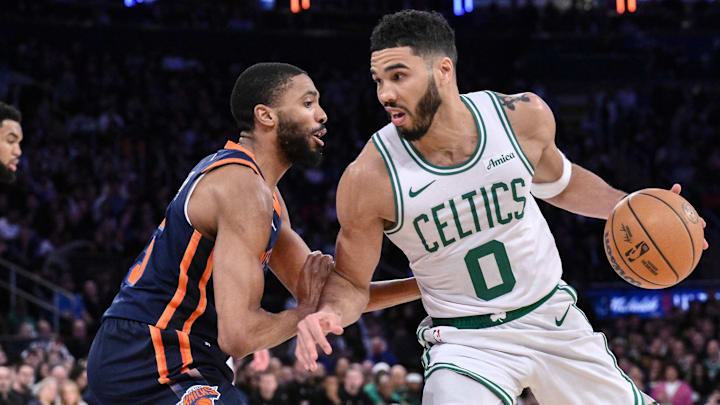Nobody is picking the New York Knicks to beat the Boston Celtics in the second round of the NBA playoffs. Even those with any inclination to consider predicting the upset are forced to rethink their optimism after an unnecessarily dramatic near-miss against the Detroit Pistons.
But there is a difference between presuming chalk, and asserting the Knicks have no chance. The Celtics are not infallible. As such, they are not unbeatable, either.
The Orlando Magic, believe it or not, proved as much in Round 1 with their defensive approach. They severely limited Boston's three-point attempts relative to the regular season. And in doing so, they drew a roadmap to dethroning the reigning champs that New York must now attempt to follow.
Aggressive three-point defense is the Celtics' kryptonite
Sure, the Magic lasted just five games against the Celtics. But they kept themselves within striking distance for a lot of the live action—and picked up a Game 3 victory—thanks to their frenetic approach guarding behind the rainbow.
Orlando limited Boston to 34.8 three-point attempts and 13.0 long-range makes per 100 possessions. That is night and day compared to the regular season, when the Celtics averaged 49.6 attempts and 18.3 makes per 100 possessions.
The Magic also made it a point to sell out and lower Beantown's shot quality on those outside looks. Just 13.6 percent of the Celtics' three-pointers went uncontested during the first round. That is almost half their unguarded mark from the regular season, which checked in at 24.8 percent.
This approach had a huge impact on Boston's results. Its overall offensive rating was right in line with its regular-season marks, but the team made, on average, six fewer three-pointers per game. Essentially, then, Orlando forced the Celtics to find 18 points a night from other resources. That is huge on the margins of an entire series.
Can the Knicks replicate Orlando's defensive success?
"Limit Boston's number and quality of looks from downtown" is a classic easier-said-than-done trope. Following the Magic's lead demands making certain adjustments, and also requires a specific set of personnel.
Orlando was committed all series to fighting around picks, and running the Celtics' shooters off the line. Even the bigs participated in the frenetic ball-screen navigation. (This is an underrated part of Paolo Banchero's game, for those who care.) Beyond the general aggression, the Magic also relied on those outside the primary action to execute pinpoint rotations when Boston dribbled inside the arc. Even the smallest mistake within this approach can result in a wide-open look or pass at the rim.
New York's defensive personnel don't measure up to Orlando's armory of pests. (That is saying something about the Magic, considering Jalen Suggs has played exactly zero minutes since the beginning of January.) Asking Jalen Brunson to fight through screens, in addition to being the all-everything on offense, is a tall and unreasonable order.
Still, the Knicks have a handful of others who can capably replicate Orlando's approach. Mikal Bridges, OG Anunoby and Josh Hart all have that fight-or-scramble gear when at their very best. Even Karl-Anthony Towns has improved his screen navigation, when given the license to do so. Head coach Tom Thibodeau can also use more pre-switching in hopes of keeping Brunson outside the primary-screening actions, which should cap the number of times he's tasked with fighting over picks.
Backstopping this approach is the tougher element of employing it. Towns cannot recover from the perimeter to the basket like Banchero, Jonathan Isaac, Wendell Carter Jr., or even Goga Bitadze. Anunoby can handle a bunch of the back-line work, but this then takes him off one of Boston's premier scorers. That is a risky gambit, and one the Knicks probably shouldn't explore unless Brunson is catching a breather, and Deuce McBridge is on the floor.
Using more Mitchell Robinson could be the skeleton key to unraveling the Celtics' offensive approach. The Knicks concede ground on offense, but Robinson has shown he still has the mobility chops to play more aggressive forms of defenses, so long as Thibs allows it. He is even more useful if Towns is the one at the level. Robinson frees him up to be as aggressive as possible, without totally selling out the back line.
Of course, the Celtics' five-out offense complicates matters. They stretch defenses even when playing dual-big units with Al Horford and Kristaps Porzingis. That could put Robinson in compromising positions.
Worrying about the ramifications of replicating Orlando's aggression, though, is for teams that didn't get thoroughly trucked by Boston during the regular season. The Knicks did. They should be open to trying anything and everything—particularly when, in this case, there's evidence to support the payoff being worth the risk.
Dan Favale is a Senior NBA Contributor for FanSided and National NBA Writer for Bleacher Report. Follow him on Bluesky (@danfavale), and subscribe to the Hardwood Knocks podcast, co-hosted by Bleacher Report's Grant Hughes.
